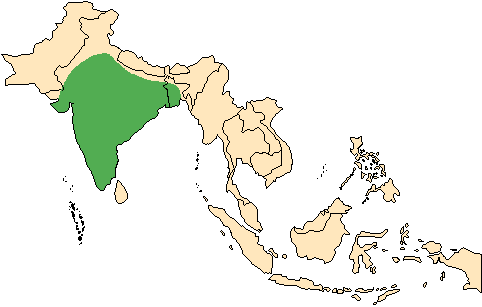![]() Return
to Artiodactyla
Return
to Artiodactyla
Classification
|
 Antilope
cervicapra
Antilope
cervicapra
Blackbuck
![]()
Taxonomy
 |
 |
 |
Click on the pictures above for a larger view of the
photographs
|
||
General Characteristics
Body Length: 100-150 cm / 3.3-5 ft.
Shoulder Height: 60-85 cm / 2-2.8 ft.
Tail Length: 10-17 cm / 4-6.8 in.
Weight: 25-35 kg / 55-77 lb.One of the few antelope which exhibits pronounced sexual dimorphism, the genders in the blackbuck are readily distinguishable. Both sexes have white underparts, including the insides of the legs and lower chest, as well as a white ring surrounding the eye and a white chin. Females and young are yellowish-fawn on their back and head, and are generally hornless. Males gradually darken from tan to deep brown or black with age, beginning after 2 years. The build is slender, and the tail short. The horns, found only in males and appearing before their pronounced colour change, are twisted in a tight spiral with up to five turns. Ridged laterally, they may grow 35-73 cm / 14-29 inches.
Ontogeny and Reproduction
Gestation Period: 5-6 months.
Young per Birth: 1
Weaning: 5-6 months.
Sexual Maturity: 1.5-2 years.
Life span: 10-12 years, rarely up to 18.Although breeding can occur throughout the year, there are peak periods in March-May and August-October.
Ecology and Behavior
During the cooler seasons, blackbuck are diurnal, and active intermittently throughout the hours of daylight. As the temperature rises, however, they are more often seen grazing in the open in the early morning and late afternoon, sheltering from the sun for the rest of the day. When a potential threat is spotted, the alert females are usually first to sound the alarm, with one individual leaping into the air. This motion is followed by the entire herd, although after a few large bounds the herd reduces its pace to a normal gallop. One of the fastest land mammals, blackbuck have been clocked going in excess of 80 kmph / 48 mph. Population densities are approximately 1 animal per 2 hectares. During the breeding season males become territorial, defending an area usually ranging in size from 1 to 17 hectares from rival males, and attempting to keep the largest group of females within it for the longest period of time. This territoriality can last anywhere from two weeks to eight months. Dominance among males within a herd is achieved primarily with posturing and threatening gestures: fights with the sharp horns are rare.Family group: Mixed herds with 5-50 animals, generally with three or fewer males. Bachelor herds are known.
Diet: Grasses, leaves, buds, field fruits.
Main Predators: Cheetah, wolf, rarely tiger and leopard.
Distribution
Dry woodland and clearings in India and eastern Pakistan.

Range Map (Redrawn from Walther, 1990)
Conservation Status
The blackbuck is considered vulnerable by the IUCN (1996).
Remarks
Previously one of the most abundant ungulate species on the Indian subcontinent, the blackbuck has been decimated due to excessive hunting for meat and sporting trophies, as well as habitat loss. However, introduced populations are thriving in Texas and Argentina, with over 20,000 animals between them. The name blackbuck is a reference to the colour of mature males. Anthalops (Greek) a horned animal, probably from anthos (Greek) a flower and ops (Greek) the eye which refers to the beautiful eyes of antelope. Cervus (Latin) a deer; capra (Latin) a she-goat.
Literature Cited
Nowak, R. M. [editor]. 1991. Walker's Mammals of the World (Fifth Edition). Baltimore: The Johns Hopkins University Press.Walther, F. R. 1990. Gazelles and related species. In Grzimek's Encyclopedia of Mammals. Edited by S. P. Parker. New York: McGraw-Hill. Volume 5, pp. 462-484.
Wilson, D. E., and D. M. Reeder [editors]. 1993. Mammal Species of the World (Second Edition). Washington: Smithsonian Institution Press. Available online at http://nmnhwww.si.edu/msw/
Return to Artiodactyla

![]()
© Brent Huffman, www.ultimateungulate.com |
|
|